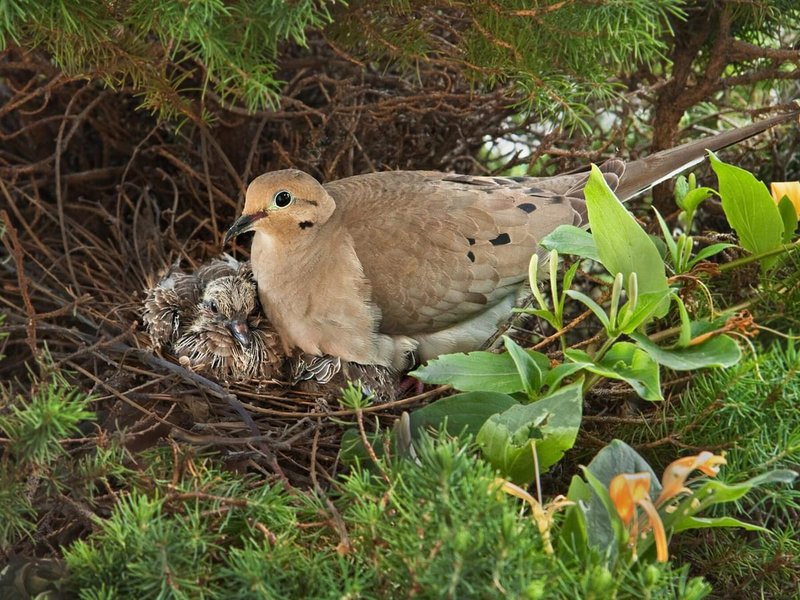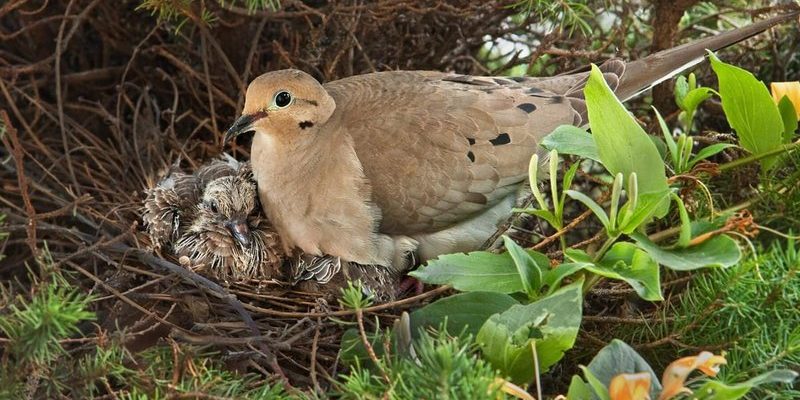
Think of doves as the peace-loving romantics of the bird world. Their cooing can feel a bit like they’re whispering sweet nothings to each other. Watching them search for mates or build their nests can remind you of a couple excitedly planning their first home together. In this article, we’ll dive into dove behavior by exploring their cooing, mating rituals, and nesting habits. Let’s get started!
The Sweet Sound of Cooing
Doves are famous for their soft cooing sounds. You might hear this during both the day and night, filling the air with a gentle melody. But what does their cooing really mean? Well, here’s the thing: cooing serves multiple purposes. It’s not simply a song of love; it’s also a way for doves to communicate.
For instance, when a male dove coos, he’s usually trying to attract a female. Think of it as his way of saying, “Hey, look at me! I’m friendly and ready to mingle!” During courtship, males can get quite elaborate with their calls, puffing up their chests and strutting around as if they’re on a catwalk. This vibrant display is more than just show—it’s a signal of good health and vigor, which is appealing to potential mates.
Interestingly, dove cooing can also serve as a way to establish territory. If another male wanders into his space, you might hear a more aggressive tone—almost like a warning. So, while these sounds might seem peaceful to us, there’s a lot of social dynamics happening underneath that cooing.
Mating Rituals: A Dance of Love
Once a male successfully attracts a female dove, the real romance begins! Their mating rituals are a beautiful sight to behold. You might find these birds engaging in a delightful dance, where they bow to each other, preen their feathers, and even chase each other around. This playful behavior helps strengthen their bond and builds trust as they prepare for nesting.
Mating usually takes place in the spring and early summer when the weather is warmer and food is abundant. Doves are monogamous, meaning they typically stick with one partner for life. This devotion is quite touching, as they rely on each other for support and care throughout their lifespan, which can be several years.
After the mating display, the female dove lays eggs in a cozy nest, usually built by both partners. This brings us to the next fascinating part of dove behavior: nesting.
Nesting: Building a Home Together
Nest-building is another captivating aspect of dove behavior. Doves prefer to create their nests in sheltered areas, often using twigs, grass, and leaves they can gather easily. The male often brings materials to the female, who arranges them just right. It’s a *team effort*, much like a couple decorating their first home together!
Once the nest is ready, the female lays one or two eggs, which are typically a light blue or white color. Both parents take turns incubating the eggs, which means they share the responsibility. This shared duty isn’t only practical; it also highlights their teamwork and commitment. Honestly, it’s pretty heartwarming!
After about two weeks, the eggs hatch into adorable, fuzzy chicks. Both parents continue to care for their young, feeding them a special substance called “pigeon milk.” This nutrient-rich fluid is produced in the parents’ crops and is essential for the chicks’ growth. It’s amazing how much effort these birds put into raising their little ones!
Doves communicate in several ways beyond cooing. Their body language plays a significant role in how they express themselves. For example, if a dove puffs up its chest, it may feel threatened or trying to assert its dominance. On the flip side, a relaxed dove with smooth feathers indicates comfort and well-being, ideal for a mate or nesting area.
Moreover, doves also have a special way of *tail signaling*. When they want to catch the attention of their partners, they might flick their tails up and down. This subtle gesture can communicate a range of feelings, from excitement to readiness to mate. It’s like a flirty wink in the dove world!
Understanding these signals can offer deeper insight into their social interactions. As you observe them, it becomes clear that doves are not just passive creatures; they actively participate in relationships and social structures, often showing remarkable intelligence and emotional depth.
Once the chicks hatch, dove parenting becomes full-on teamwork. Both parents are highly involved, working together to feed and protect their young. You might see them taking turns attending to the chicks, ensuring they’re always fed and safe from predators.
Interestingly, young doves (or squabs) grow quickly and are usually ready to leave the nest in just a few weeks. During this time, they rely heavily on their parents to provide warmth and nourishment. This nurturing bond showcases how dedicated doves are to their families. Just like human parents, they have to make sacrifices and prioritize their young, often at the expense of their comfort.
Once the chicks fledge and start exploring their surroundings, the parents may continue to keep an eye on them for a little while. Doves are protective and will defend their young from threats. Their commitment to parenting is truly admirable, reflecting the deep connection they share.
If you’re curious about observing doves, they’re fairly common in open areas like parks, gardens, and even some urban spaces. They love to forage for seeds and grains, often seen pecking at the ground. Watching them interact can be genuinely enjoyable and insightful, as you’ll see their cooing, mating, and nesting behaviors up close.
If you want to attract doves to your backyard, consider placing bird feeders filled with seeds. You might also create a cozy spot with nesting materials, such as twigs and straw. This not only helps support local wildlife but also grants you the chance to witness their charming activities firsthand.
Remember, every little interaction contributes to a bigger picture of dove behavior, and being a part of that can be heartwarming.
Dove behavior, from their sweet cooing to their dedicated parenting, reveals a rich tapestry of life that goes beyond mere survival. These birds are romantic, nurturing, and social creatures that thrive on connection—traits we often admire in our own lives.
Whether you’re simply observing them in your backyard, learning about their rituals, or even considering how to help them, the world of doves offers an endearing glimpse into nature. Honestly, taking the time to understand and appreciate these gentle birds can deepen your connection to wildlife and enrich your experience in the great outdoors. Next time you hear that soft cooing, you’ll know there’s a lot more going on than just a pretty sound!

